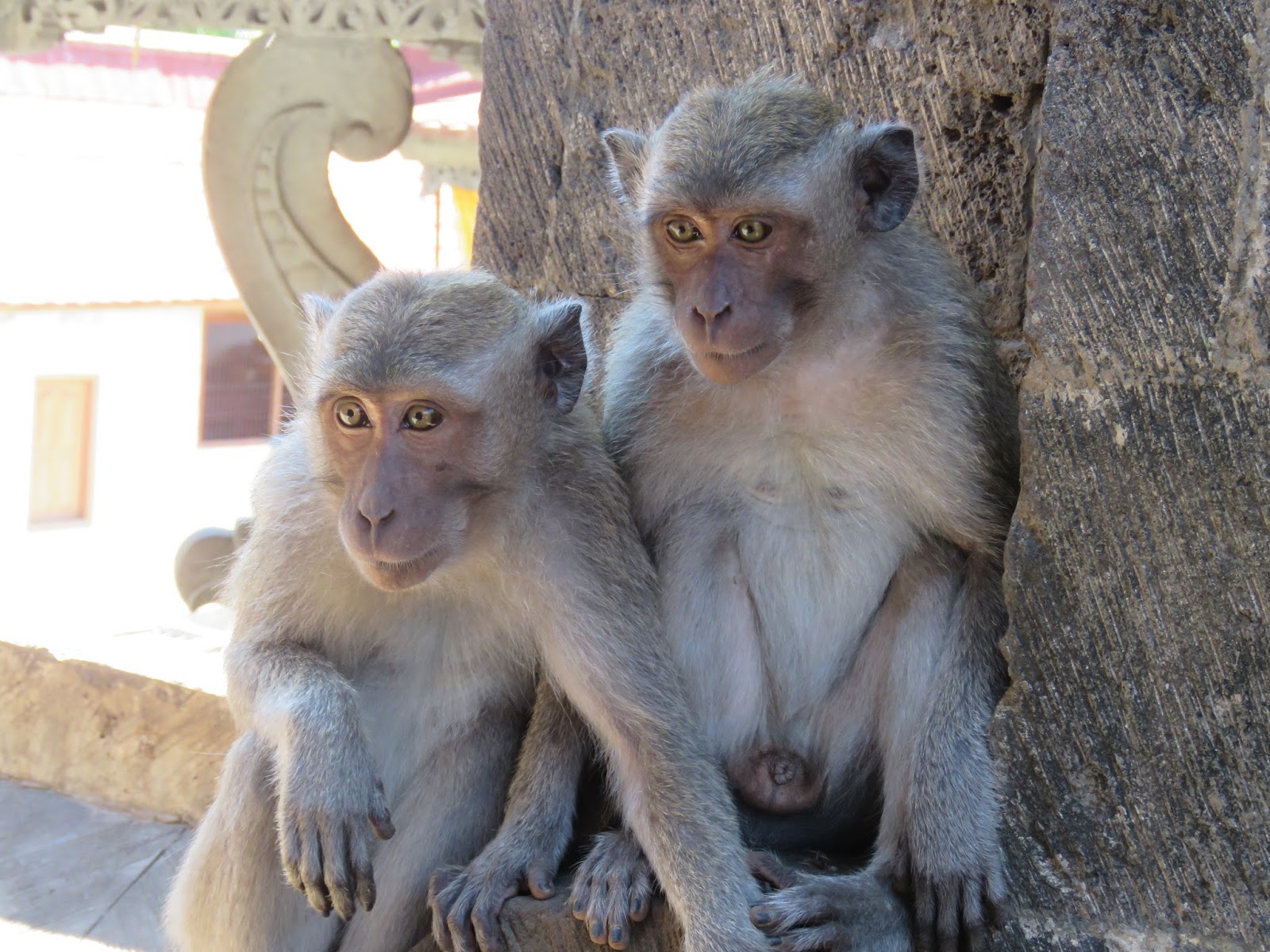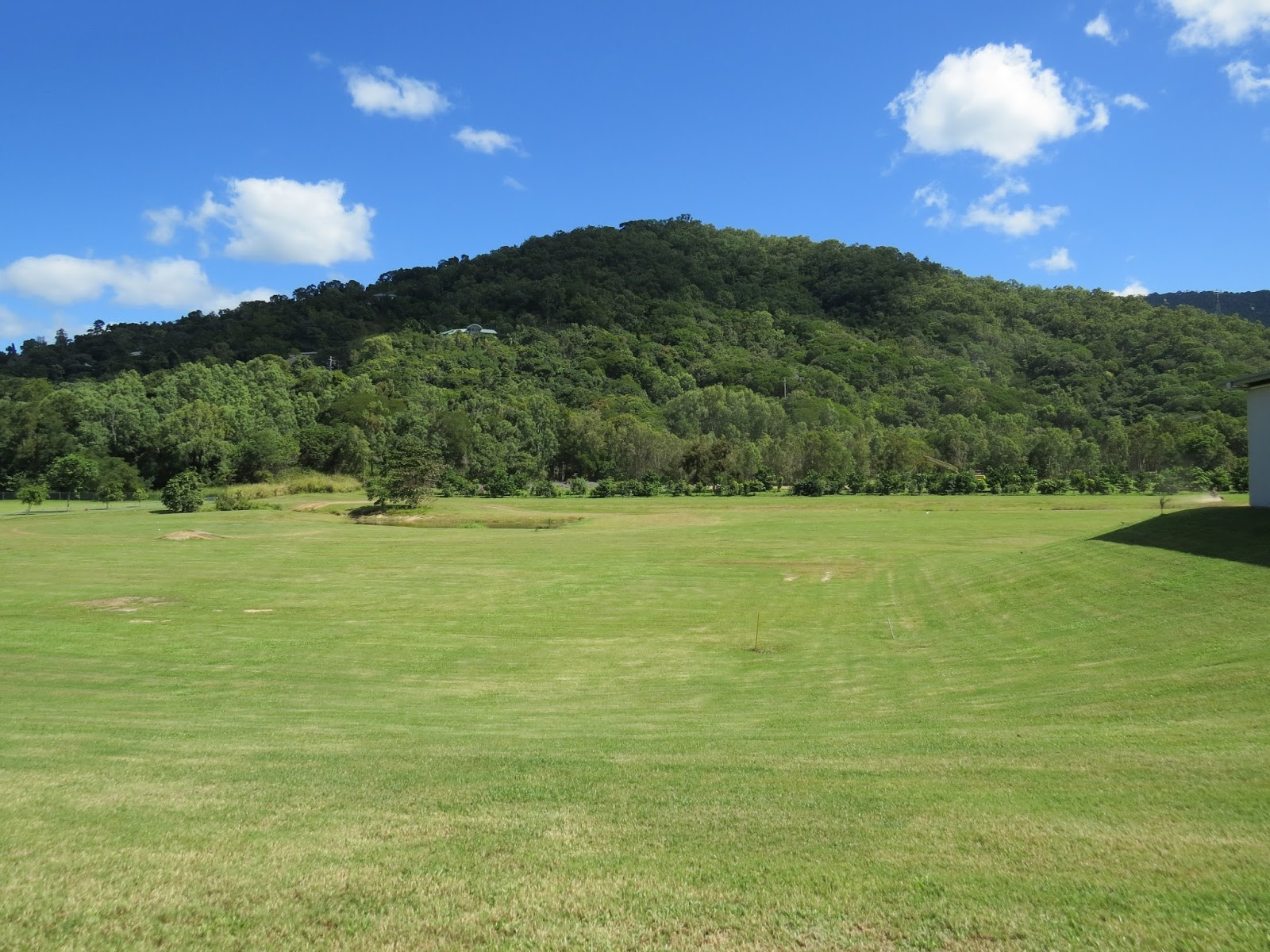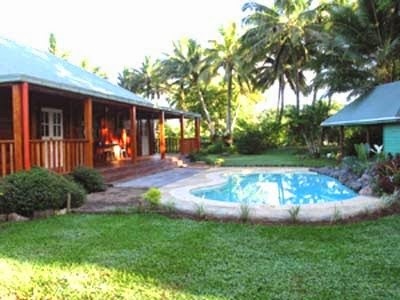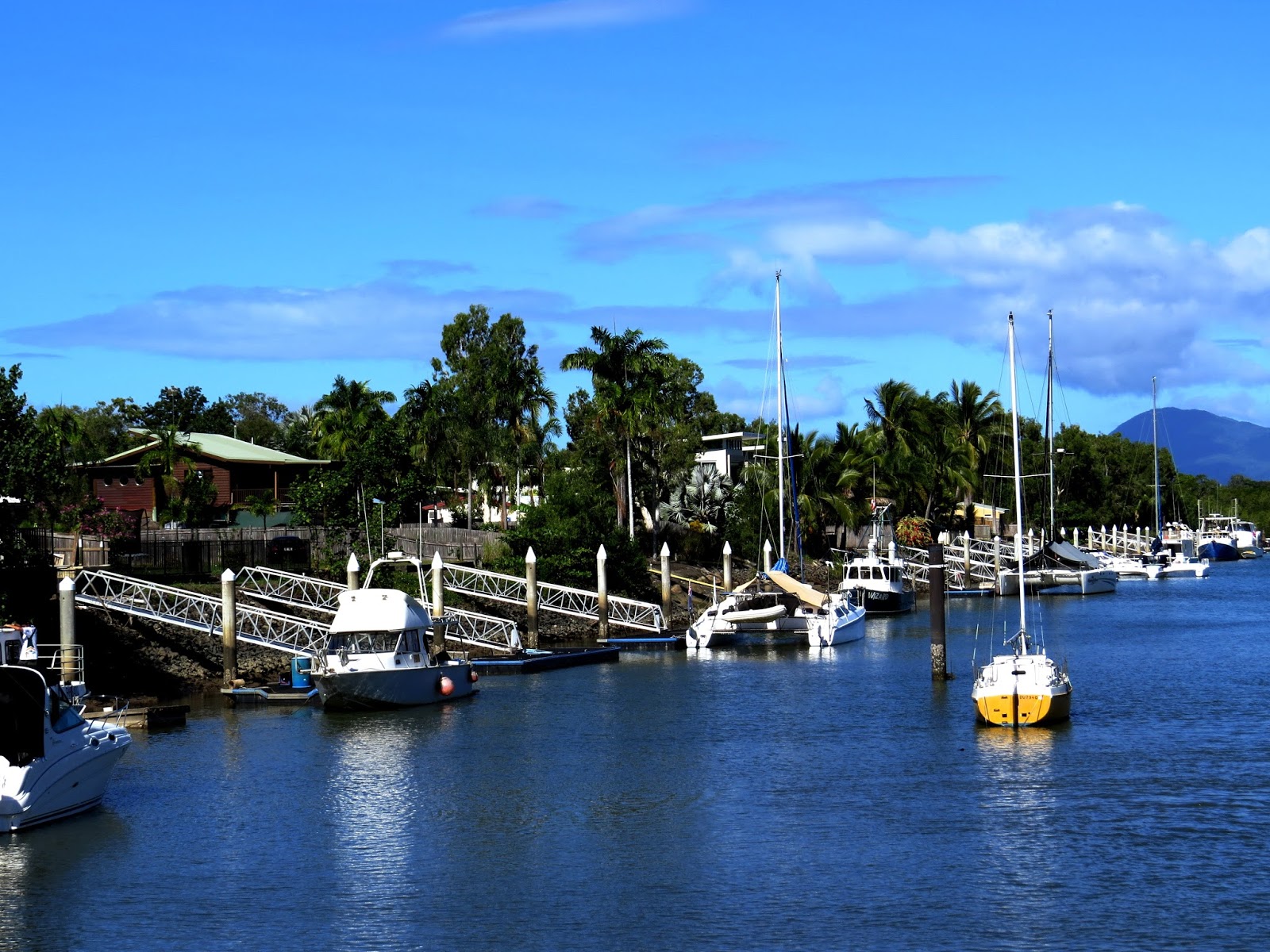 |
| Here we are wearing saris standing at the foot of the steps at the Pulaki Temple in Singaraja. This isn’t the first time Tom’s worn a dress/skirt. Please see below. |
“Sightings on the Beach in Bali”
 |
| At quite a distance…a barge carrying coal, pulled by a tugboat. |
On the return trip from Lovina to the villa, the second tourist attraction we visited was the Pulaki Temple as described on this website:
“Pulaki Temple or Pura Pulaki is a Hindu shrine located on the hill bank with a beautiful beach just in front of the temple located in the north part of Bali. It is one of the biggest Hindu temples in Bali situated in the coastal side west part of Singaraja town or 1-hour drive to the west from the town. This temple is set on flat land with a stone hill bank as a backdrop meanwhile the blue ocean is just in front of the temple. The holy group of monkeys is living around the temple and keeps the temple from the bad influences according to what the local people believe. These monkeys are coming from the Macaca fascicularis group or Long-Tailed Macaque. Pulaki Temple is one of the places appointed by Bali’s government as a tourist destination that you must visit when traveling to Bali in particular north part the island.”
 |
| Bat-like ears on this monkey. |
We were the only tourists at the popular location during the entire visit. Our driver, Butu, escorted us through the temple having been there many times in the past with other tourists. His English is limited, although he managed to communicate a few key aspects worthy of note.
 |
| These two were sitting on a wall observing the activities of the others. |
We were charged a nominal fee for the cost of the saris, IDR $50,000, US $3.69 (for both) which are required to be worn upon entering a Hindu temple. It was hot and humid but this level of dress wasn’t nearly as uncomfortable as it was when I wore the “abaya” and Tom wore a “thobe” when we visited the White Mosque in Abu Dhabi, UAE as shown in this photo below, coincidentally about three years ago in the latter part of May. Here’s the link to that post in 2013.
 |
| In 2013, we stayed in Dubai for two weeks in a high-rise vacation condo. Unfortunately, I was ill during our entire stay in Dubai with an awful virus and sinus infection, which developed during the prior Middle Eastern cruise. It was during this time while I was still ill, that we visited the White Mosque in Abu Dhabi. The temperature that day was at least 40C, 104F. The black silky fabric over my long pants was uncomfortable. Tom was OK in the cooler, lighter fabric of the white thobe. |
The attendant at the Pulaki Temple dressed us, over our clothes, in the sari with the accompanying waistband. Tom had a bit of difficulty walking with the long skirt reaching to the ground.
Many of us have worn our share of long skirts and dresses, easily able to walk without tripping. I laughed when he mumbled under his breath about the tangled fabric around his legs, making walking up the steps difficult.
 |
| Nice teeth! |
We were both fascinated with the design of the temple, taking many photos we’ll share over the next few days. I was particularly excited to take photos of the Long Tailed Macaque monkeys who were relatively tame but nonetheless wild animals.
 |
| In many ways, they’re so much like us. |
At night, the monkeys live in the forest behind the temple, visiting the temple during the day when they’re fed not only by the religious personnel but also by the tourists. They weren’t as pesky as we’d expected although on a few occasions they wrapped their arms around our legs.
 |
| A baby hanging on for dear life! Notice the little point atop the mom’s head. |
We’d read stories online about tourists being bite by monkeys at temples although not a common occurrence. In any case, it made sense to stay back a reasonable distance as we’ve learned in our travels after spending considerable time in the presence of wild animals. They are “wild” after all. =And, even tame animals, especially monkeys, can attack unprovoked.
 |
| This monkey had lost an eye. |
Now on to the embarrassing part…
After we were satisfied we’d seen all we wanted to see and do at the Pulaki Temple we’d handed back our saris. I asked for “toilet” a word commonly recognized the world over as opposed to asking for a “restroom” or “ladies or men’s room.” In many countries, the letters “WC” for “water closet” are posted at the appropriate locations.
 |
| This fellow checked us out as we entered the temple. |
We were pointed in the direction of the water closet, a short distance from the entrance area to the temple requiring we walk over uneven terrain and a grassy yard without a path. An attendant followed us to collect the payment for using the WC of IDR $2000, US $.15 which Tom handed her promptly.
Opening the door to the WC, I was stunned. This was a first for me in all of our world travels to date, keeping in mind, that I try to avoid using public facilities as much as possible. here was no toilet so to speak, only this similar porcelain lined hole in the floor as shown in this photo I found online:
 |
| Not our photo. (I never take the camera into a WC with me). Some of these squatting toilets are raised a little. The one I used at the temple was flush (no pun intended) with the floor as shown. |
This isn’t a position I find required in our daily lives. And, at my age of 68, not one I can easily maneuver purely from lack of practice, although now I may start working on this particular stance.
 |
| Angry statues at Hindu temples are intended to keep “evil” and “bullies” away. |
Recalling how well I mastered peeing in odd situations referred to as “checking the tire pressure” as our guide, Anderson described during our safari in the Maasai Mara in October 2103, I wondered how I’d manage this.
But, I ran into a few obstacles; one, I was wearing long pants; two, I couldn’t take the pants off without removing my shoes and the floor to the small enclosure was very wet. There was no way I was going to stand in bare feet on that floor. Plus, my pants would undoubtedly get wet as I removed them.
 |
| Cats are often depicted at temples. |
As fit as I attempt to be, considering my precarious spinal condition, there was no way I could keep my pants on without getting them soaked from the floor while attempting to “check the tire pressure” which over the long drive and sipping on my iced tea definitely had become an urgent situation.
 |
| Holding onto a pole while thinking. |
I challenge any of our dear female readers to undertake this position with your pants still on. If you can do this, I’d love to hear from you and how you accomplished it. Keeping in mind, there was no place to hold onto for support. Had there been, I may have been able to accomplish it.
 |
| We didn’t want to disturb the monks to discover what they were doing. For more on Hinduism, please click this informative link. |
Alas, “checking the tire pressure” resulted in my peeing all over my light tan pants. Oh, by the way, there was no light and no window in the little room. It was completely dark. I couldn’t even see “where” to aim, let alone be in an appropriate position while aiming.
Not wanting to draw attention to myself when I exited the WC, well aware my pants were entirely soaked, Tom walked back to the car close behind me. Luckily, I had a pair of shorts in the bag which I’d intended to change into at some point but never had.
 |
| Looks like a teenager with that hairdo. |
Both the immigration office and the temple require visitors to wear long pants. I changed in the car while Butu and Tom waited outside. With the seat pulled forward all the way for Tom’s legs in the backseat, even getting changed wasn’t all that easy. At this point, I was hot and sweaty from both experiences.
I placed my pants on the floor in the backseat for the remaining one-hour drive back to the villa, hand washing them with laundry soap in the bathroom sink when we returned. Whew!
 |
| Watching and waiting for action. |
Was I the first female tourist that had such an experience at that or other “squatting required” toilets? Probably not. Nor will I be the last. Embarrassed? Certainly not in front of Tom and I doubt Butu or the temple staff noticed me. I supposed it was a “foolish me” moment, one that I’ve already found myself chuckling about.
However, it was a lesson learned about cultural differences. Guess I’d better start working on those deep knee squats…with pants on and pulled down of course.
Photo from one year ago today, May 27, 2015:
 |
| Tom’s miniature lemon meringue pie for dessert on the first night aboard the cruise from Honolulu to Sydney. For more cruise photos, please click here. |


































































































